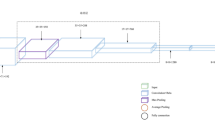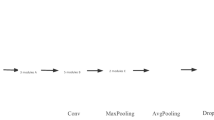Abstract
Ancient murals recording histories and myths are suffering different types of deteriorations, which makes these valuable cultural heritage unrecoverable. For preventive protection of ancient murals, the researchers need to rate the grade of the mural deteriorations. However, the present grading is mainly rely on the experience of the cultural relics’ protection staff. In this paper, we propose to learn a mural deterioration grading network (MDGN) for generating robust and accurate mural deterioration grading. MDGN has similar architecture with AlexNet but with less network parameters. We built two small mural deterioration grading datasets on briquettes and real grottoes. We use image patches to generate enough training samples for MDGN. Dense pixel-level grading can be obtained by the means of sliding window. Extensive experiments on simulated data and real murals verify the effectiveness of the proposed ancient mural deterioration grading method. Our method achieves superior grading results on both quantitative and qualitative comparisons with baseline.






Similar content being viewed by others
References
Chen LC, Papandreou G, Kokkinos I, Murphy K, Yuille AL (2017) Deeplab: semantic image segmentation with deep convolutional nets, atrous convolution, and fully connected crfs. IEEE Trans Pattern Anal Mach Intell 99:1–2. https://doi.org/10.1109/TPAMI.2017.2699184
Chen LC, Papandreou G, Kokkinos I, Murphy K, Yuille AL (2018) Deeplab: semantic image segmentation with deep convolutional nets, atrous convolution, and fully connected crfs. IEEE Trans Pattern Anal Mach Intell 40(4):834–848
Feng W, Liu ZQ (2008) Region-level image authentication using bayesian structural content abstraction. IEEE Trans Image Process 17(12):2413–2424
Feng W, Jia J, Liu ZQ (2010) Self-validated labeling of markov random fields for image segmentation. IEEE Trans Pattern Anal Mach Intell 32(10):1871–1887
Feng W, Tian FP, Zhang Q, Zhang N, Wan L, Sun J (2015) Fine-grained change detection of misaligned scenes with varied illuminations. In: IEEE international conference on computer vision, pp 1260–1268
Glorot X, Bengio Y (2010) Understanding the difficulty of training deep feedforward neural networks. In: Proceedings of the thirteenth international conference on artificial intelligence and statistics, pp 249–256
Huang R, Feng W, Fan M, Guo Q, Sun J (2017a) Learning multi-path cnn for mural deterioration detection. J Ambient Intell Hum Comput 27:1–8
Huang R, Feng W, Wang Z, Fan M, Wan L, Sun J (2017b) Learning to detect fine-grained change under variant imaging conditions. In: IEEE international conference on computer vision workshop, pp 2916–2924
Huang R, Feng W, Fan M, Wan L, Sun J (2018) Multiscale blur detection by learning discriminative deep features. Neurocomputing 285:154–166
Jia Y, Shelhamer E, Donahue J, Karayev S, Long J, Girshick R, Guadarrama S, Darrell T (2014) Caffe: convolutional architecture for fast feature embedding. arXiv preprint arXiv:14085093
Koltun V (2011) Efficient inference in fully connected crfs with gaussian edge potentials. In: International conference on neural information processing systems, pp 109–117
Krizhevsky A, Sutskever I, Hinton GE (2012) Imagenet classification with deep convolutional neural networks. In: International conference on neural information processing systems, pp 1097–1105
Long J, Shelhamer E, Darrell T (2015) Fully convolutional networks for semantic segmentation. In: IEEE conference on computer vision and pattern recognition, pp 3431–3440
Papandreou G, Chen LC, Murphy K, Yuille AL (2015) Weakly-and semi-supervised learning of a dcnn for semantic image segmentation. In: International conference on computer vision, https://doi.org/10.1109/ICCV.2015.203
Pinchin S (2013) Historical perspectives on preventive conservation. J Arch Conserv 4119(1):1–3
Prasomphan S, Jung JE (2017) Mobile application for archaeological site image content retrieval and automated generating image descriptions with neural network. Mob Netw Appl 22(4):642–649
Tighe J, Lazebnik S (2010) Superparsing: scalable nonparametric image parsing with superpixels. In: European conference on computer vision, pp 352–365
Tighe J, Lazebnik S (2013) Finding things: Image parsing with regions and per-exemplar detectors. In: Computer vision and pattern recognition, pp 3001–3008
Wirilander H (2012) Preventive conservation: a key method to ensure cultural heritages authenticity and integrity in preservation process. e-Conserv Mag 5(24):164–176
Zheng S, Jayasumana S, Romera-Paredes B, Vineet V, Su Z, Du D, Huang C, Torr PH (2015) Conditional random fields as recurrent neural networks. In: International conference on computer vision, https://doi.org/10.1109/ICCV.2015.179
Acknowledgements
This work was supported in part by the National Natural Science Foundation of China under Grant Nos. 61671325 and Grant 61572354, and in part by the National Science and Technology Support Project 2013BAK01B01.
Author information
Authors and Affiliations
Corresponding author
Additional information
Publisher's Note
Springer Nature remains neutral with regard to jurisdictional claims in published maps and institutional affiliations.
Rights and permissions
About this article
Cite this article
Qian, K., Zhang, P., Huang, R. et al. Learning to grade deterioration for ancient murals. J Ambient Intell Human Comput 15, 1727–1734 (2024). https://doi.org/10.1007/s12652-019-01487-9
Received:
Accepted:
Published:
Issue Date:
DOI: https://doi.org/10.1007/s12652-019-01487-9




